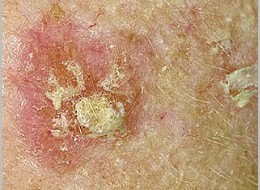Actinic keratoses, also known as solar keratoses, are small rough or scaly areas of skin due to damage from sun exposure. Some actinic keratoses can turn into squamous cell skin cancer, so it is important to perform self-examinations often and catch them early.
People with fair skin who sunburn easily; have trouble tanning; have blue, green, or hazel eyes; and red or blond hair are most at risk for developing actinic keratoses. Those who have had a lot of sun exposure in their youth are at a high risk as well. Those with a weak immune system due to chemotherapy, HIV, or an organ transplant are at higher risk.
Spots usually appear in those who are older (over 50), but they can start appearing in younger adults who have had a lot of sun exposure. Darker-skinned individuals are rarely affected.
Signs and Symptoms
The sun-exposed areas of the face, scalp (where balding), ears, neck, forearms, and backs of the hands are most commonly affected with actinic keratoses, but any skin area frequently exposed to sun can be involved.
Patches are usually less than an inch in size with slight scale (sometimes thick like a wart) and a pink, red, or brownish color. They are slightly rough to the touch, like fine sandpaper, and may be a bit sensitive.
Mild – one or two spots, not thick or hardModerate – scattered, few spotsSevere – numerous or thick, hard, or bleeding spots
If you have severe changes or have a spot that is growing or bleeding, see the doctor. Sometimes a biopsy may be done to look for skin cancer.
Local destruction with freezing (cryosurgery), scraping (curettage), burning (electrocautery), dermabrasion, or a laserCreams with either tretinoin, adapalene, fluorouracil, diclofenac, or imiquimodChemical peelingPhotodynamic therapy
